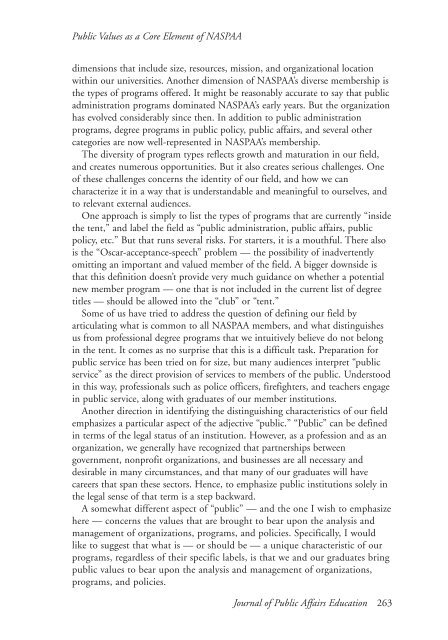journal of public affairs education - NASPAA *The Global Standard ...
journal of public affairs education - NASPAA *The Global Standard ...
journal of public affairs education - NASPAA *The Global Standard ...
- No tags were found...
Create successful ePaper yourself
Turn your PDF publications into a flip-book with our unique Google optimized e-Paper software.
Public Values as a Core Element <strong>of</strong> <strong>NASPAA</strong>dimensions that include size, resources, mission, and organizational locationwithin our universities. Another dimension <strong>of</strong> <strong>NASPAA</strong>’s diverse membership isthe types <strong>of</strong> programs <strong>of</strong>fered. It might be reasonably accurate to say that <strong>public</strong>administration programs dominated <strong>NASPAA</strong>’s early years. But the organizationhas evolved considerably since then. In addition to <strong>public</strong> administrationprograms, degree programs in <strong>public</strong> policy, <strong>public</strong> <strong>affairs</strong>, and several othercategories are now well-represented in <strong>NASPAA</strong>’s membership.The diversity <strong>of</strong> program types reflects growth and maturation in our field,and creates numerous opportunities. But it also creates serious challenges. One<strong>of</strong> these challenges concerns the identity <strong>of</strong> our field, and how we cancharacterize it in a way that is understandable and meaningful to ourselves, andto relevant external audiences.One approach is simply to list the types <strong>of</strong> programs that are currently “insidethe tent,” and label the field as “<strong>public</strong> administration, <strong>public</strong> <strong>affairs</strong>, <strong>public</strong>policy, etc.” But that runs several risks. For starters, it is a mouthful. There alsois the “Oscar-acceptance-speech” problem — the possibility <strong>of</strong> inadvertentlyomitting an important and valued member <strong>of</strong> the field. A bigger downside isthat this definition doesn’t provide very much guidance on whether a potentialnew member program — one that is not included in the current list <strong>of</strong> degreetitles — should be allowed into the “club” or “tent.”Some <strong>of</strong> us have tried to address the question <strong>of</strong> defining our field byarticulating what is common to all <strong>NASPAA</strong> members, and what distinguishesus from pr<strong>of</strong>essional degree programs that we intuitively believe do not belongin the tent. It comes as no surprise that this is a difficult task. Preparation for<strong>public</strong> service has been tried on for size, but many audiences interpret “<strong>public</strong>service” as the direct provision <strong>of</strong> services to members <strong>of</strong> the <strong>public</strong>. Understoodin this way, pr<strong>of</strong>essionals such as police <strong>of</strong>ficers, firefighters, and teachers engagein <strong>public</strong> service, along with graduates <strong>of</strong> our member institutions.Another direction in identifying the distinguishing characteristics <strong>of</strong> our fieldemphasizes a particular aspect <strong>of</strong> the adjective “<strong>public</strong>.” “Public” can be definedin terms <strong>of</strong> the legal status <strong>of</strong> an institution. However, as a pr<strong>of</strong>ession and as anorganization, we generally have recognized that partnerships betweengovernment, nonpr<strong>of</strong>it organizations, and businesses are all necessary anddesirable in many circumstances, and that many <strong>of</strong> our graduates will havecareers that span these sectors. Hence, to emphasize <strong>public</strong> institutions solely inthe legal sense <strong>of</strong> that term is a step backward.A somewhat different aspect <strong>of</strong> “<strong>public</strong>” — and the one I wish to emphasizehere — concerns the values that are brought to bear upon the analysis andmanagement <strong>of</strong> organizations, programs, and policies. Specifically, I wouldlike to suggest that what is — or should be — a unique characteristic <strong>of</strong> ourprograms, regardless <strong>of</strong> their specific labels, is that we and our graduates bring<strong>public</strong> values to bear upon the analysis and management <strong>of</strong> organizations,programs, and policies.Journal <strong>of</strong> Public Affairs Education 263
















